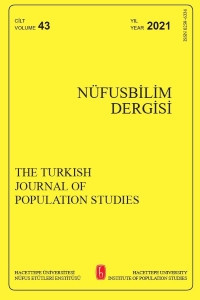Türkiye Nüfusu İçin Stokastik Ölümlülük Modelleri
Ölümlülük tahminleri, demografi ve aktüerya bilimlerinde önemli bir rol oynamaktadır. Önceki ölümlülük modellemesi çalışmalarında, zaman bağlı olarak ölüm oranlarındaki olası değişimler dikkate alınmamaktaydı. Zaman içinde bu değişimleri dikkate alan birçok stokastik ölümlülük modelleme yöntemleri geliştirilmiştir. Bu çalışmanın amacı, Türkiye ölümlülüğünü incelemek ve kuşak etkisi olup olmadığını araştırmaktır. Ölüm sayıları ve riske maruz kalan birim sayıları, kadın ve erkekler için ayrı ayrı modellenmiştir. Karşılaştırma yapmak amacıyla, BIC değerleri, standartlaştırılmış artıklar, yaşlara ve takvim yılına göre tanımlanmış bazı artık karakteristikleri kullanılmış ve. kadın ve erkek ölüm hızlarının modellemesinde takvim yılı ve kuşak etkilerinin önemli olduğu görülmüştür.
STOCHASTIC MORTALITY MODELS FOR THE POPULATION OF TURKEY
Mortality forecasts are playing an important role for demography and actuarial science. Early attempts to model mortality did not take account of potential future improvements in mortality rates. Many stochastic mortality modelling methodologies are developed in time. The aim of this paper is to have a close look at Turkish mortality and see whether there are any patterns suggestive of cohort effects. Deaths and exposures to risk of male and female population are modelled seperately. For the sake of comparison, BIC values, standardized residuals and some residual characteristics, which are defined by ages and years are used. As a result, it is found that calendar year and cohort effect are important for male and female mortality rate modelling.
___
- Biffi P., Clemente G.P., (2012), “Selecting stochastic mortality models for the Italian population”, Decisions Economics and Finance, DOI 10.1007/s10203-012-0131-9.
- Booth, H., Maindonald, J. and Smith, L., (2002), “Age-Time Interactions in Mortality Projection:Applying Lee-Carter to Australia”, ANU, Demography and Sociology Program, Research School of Social Sciences, Working Papers No. 85.
- Cairns, A.J.G., Blake, D., and Dowd, K., (2006a), “Pricing death: Frameworks for the valuation and securitization of mortality risk", ASTIN Bulletin, 36: 79-120.
- Cairns, A.J.G., Blake, D., and Dowd, K., (2006b), “A Two-Factor Model for Stochastic Mortality with Parameter Uncertainty: Theory and Calibration", Journal of Risk and Insurance, 73: 687-718.
- Cairns, A.J.G., Blake, D., Dowd, K., Coughlan, G.D., Epstein, D., Ong, A., Balevich, I., (2007), “A quantitative comparison of stochastic mortality models using data from England & Wales and the United States”, The Pensions Institute, 13(1):1–35.
- Currie, I.D., (2006), “Smoothing and forecasting mortality rates with P-splines", Talk given at the Institute of Actuaries, June 2006.
- Demircioğlu, S., Büyükyazıcı, M., (2013), “Poisson log-bilineer yaklaşımıyla Lee-Carter modellemesi ve Türkiye Uygulaması”, İstatistikçiler Dergisi, Vol. 6, 14-40.
- Gençtürk Y., Genç T., (2012), “Türkiye il-ilçe merkezlerindeki ölüm oranlarının trend ve Lee-carter yöntemleri ile tahmini”, Anadolu Üniversitesi Bilim ve Teknoloji Dergisi – B, 2 (1), 63-74.
- Gerber H.U., 1997, “Life Insurance Mathematics”, Springer, Berlin.
- Gompertz B., (1825), “On the nature of the function expressive of the law of human mortality”, Phil. Trans. Roy. Soc., 115, 513-585.
- Heligman L., Pollard J.H., (1980), “The age pattern of mortality”, Journal of the Institute of Actuaries, 107, 49-80.
- Koissi, M.C., Shapiro, A.F., (2008), “The Lee-Carter Model Under The Condition of Variables Age Specific Parameters”, Actuarial Research Conference, Regina, Canada, 2.
- Kul, F. , 2014, “Ölümlülük Yapısındaki Değişimin Modellenmesi ve Projeksiyonu”, Hacettepe Üniversitesi, Fen Bilimleri Enstitüsü, Aktüerya Bilimleri AnaBilim Dalı, Doktora Tezi (Devam ediyor).
- Lee, R.D. , Carter, L., (1992), “Modeling and Forecasting U.S. Mortality”, Journal of the American Statistical Association, 87, 419.
- Li J.S., Hardy M.R., Tan K.S., (2009), “Uncertainty in Mortality Forecasting: An extension to the classical Lee-Carter approach”, ASTIN Bulletin, 39 (1), 137-164.
- Makeham, W.M., (1867), “On the law of mortality”, Journal of the Institute of Actuaries, 8, 325-358.
- Plat, R., (2009), “On stochastic mortality modeling”, Insurance: Mathematics and Economics, 45 (3), 393–404.
- Renshaw, A.E., Haberman, S.A., (2006), “Cohort based extension to the Lee–Carter model for mortality reduction factors”, Insurance: Mathematics and Economics, 38 (3), 556–570.
- Tabeau, E., Van Den Berg Jeths, A. , Heathcote, C., (2001), “Forecasting Mortality in Developed Countries Insights From A Statistical, Demographic, and Epidemiological Perspective”, Demographic and Epidemiological Perspective, Kluwer Academic Publishers, London, 3,5,7.
- Yıldırım F., (2010), “Türkiye Ölümlülük Yapısının Lee-Carter ve Bulanık Lee-Carter İle Modellenmesi”, Hacettepe Üniversitesi, Fen Bilimleri Enstitüsü Yüksek Lisans Tezi. http://www.turkstat.gov.tr/
- ISSN: 0259-6334
- Başlangıç: 1979
- Yayıncı: Hacettepe Üniversitesi
Sayıdaki Diğer Makaleler
Türkiye Nüfusu İçin Stokastik Ölümlülük Modelleri
Kadınların Bakış Açısından Kürtaj
Alanur ÇAVLİN, Sabahat TEZCAN, Banu ERGÖÇMEN
TNSA VERİLERİNDEN SEÇİLMİŞ DEMOGRAFİK GÖSTERGELERİN TEKRAR HESAPLANMASI: TABAKALAMANIN ETKİSİ
Tuğba ADALI, A. Sinan TÜRKYILMAZ
